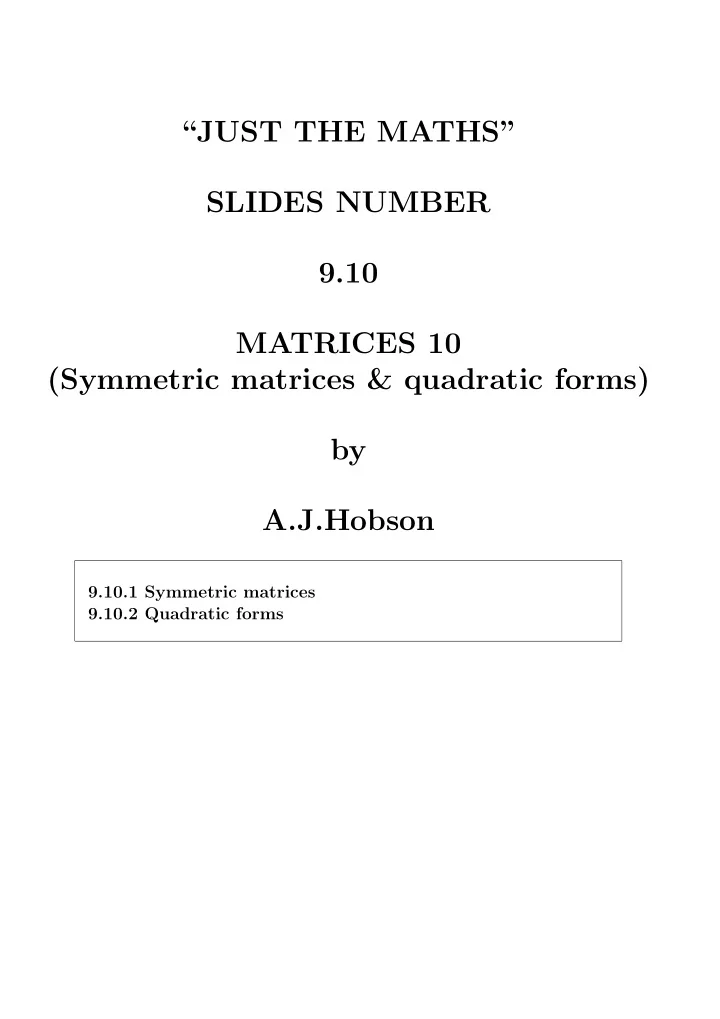

“JUST THE MATHS” SLIDES NUMBER 9.10 MATRICES 10 (Symmetric matrices & quadratic forms) by A.J.Hobson 9.10.1 Symmetric matrices 9.10.2 Quadratic forms
UNIT 9.10 - MATRICES 10 SYMMETRIC MATRICES AND QUADRATIC FORMS 9.10.1 SYMMETRIC MATRICES We state the following without proof: (i) All of the eigenvalues of a symmetric matrix are real and, hence, so are the eigenvectors. (ii) A symmetric matrix of order n × n always has n linearly independent eigenvectors. (iii) For a symmetric matrix, suppose that X i and X j are linearly independent eigenvectors associated with different eigenvectors; then X i X T j ≡ x i x j + y i y j + z i z j = 0 . We say that X i and X j are “mutually orthogonal” . If a symmetric matrix has any repeated eigenvalues, it is still possible to determine a full set of mutually orthogonal eigenvectors, but not every full set of eignvectors will have the orthogonality property. 1
(iv) A symmetric matrix always has a modal matrix whose columns are mutually orthogonal. When the eigen- values are distinct, this is true for every modal matrix. (v) A modal matrix, N, of normalised eigenvectors is an orthogonal matrix. ILLUSTRATIONS 1. If N is of order 3 × 3, we have 1 0 0 x 1 y 1 z 1 x 1 x 2 x 3 N T .N = x 2 y 2 z 2 . y 1 y 2 y 3 = 0 1 0 . 0 0 1 x 3 y 3 z 3 z 1 z 2 z 3 2. It was shown, in Unit 9.6, that the matrix 3 2 4 A = 2 0 2 4 2 3 has eigenvalues λ = 8 , and λ = − 1 (repeated), with associated eigenvectors − 1 − 1 2 − 1 2 β − γ 2 1 , and β 1 + γ 0 α β . ≡ 2 0 1 γ 2
A set of linearly independent eigenvectors may therefore be given by − 1 2 − 1 2 X 1 = 1 X 2 = 1 and X 3 = 0 , , . 2 0 1 Clearly, X 1 is orthogonal to X 2 and X 3 , but X 2 and X 3 are not orthogonal to each other. However, we may find β and γ such that − 1 − 1 − 1 2 1 + γ 0 is orthogonal to 0 β . 0 1 1 We simply require that 1 2 β + 2 γ = 0 or β + 4 γ = 0 . This will be so, for example, when β = 4 and γ = − 1. 3
A new set of linearly independent mutually orthogonal eigenvectors can thus be given by 2 − 1 − 1 X 1 = 1 X 2 = 4 and X 3 = 0 , , . 2 − 1 1 9.10.2 QUADRATIC FORMS An algebraic expression of the form ax 2 + by 2 + cz 2 + 2 fyz + 2 yzx + 2 hxy is called a “quadratic form” . In matrix notation, it may be written as a h g x ≡ X T AX , [ x y z ] h b f y g f c z and we note that the matrix, A, is symmetric. In the scientific applications of quadratic forms, it is de- sirable to know whether such a form is (a) always positive; (b) always negative; (c) both positive and negative. 4
It may be shown that, if we change to new variables, ( u, v, w ), using a linear transformation, X = PU , where P is some non-singular matrix, then the new quadratic form has the same properties aas the original, concerning its sign. We now show that a good choice for P is a modal matrix, N, of normalised, linearly independent, mutually orthog- onal eigenvectors for A. Putting X = NU, the expression X T AX becomes U T N T ANX. But, since N is orthogonal when A is symmetric, N T = N − 1 and hence N T AN is the spectral matrix, S, for A. The new quadratic form is therefore 0 0 λ 1 u U T SU ≡ [ u w ] . 0 0 v λ 2 . v 0 0 λ 3 w ≡ λ 1 u 2 + λ 2 v 2 + λ 3 w 2 . 5
Clearly, if all of the eigenvalues are positive, then the new quadratic form is always positive; and, if all of the eigenvalues are negative, then the new quadratic form is always negative. The new quadratic form is called the “canonical form under similarity” of the original quadratic form. 6
Recommend
More recommend